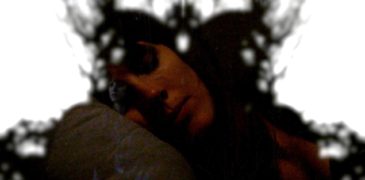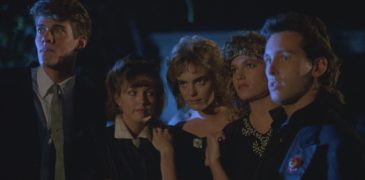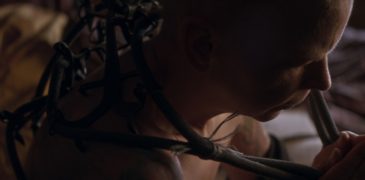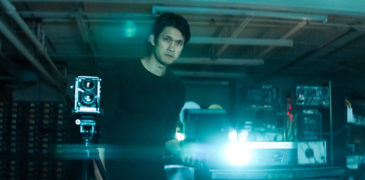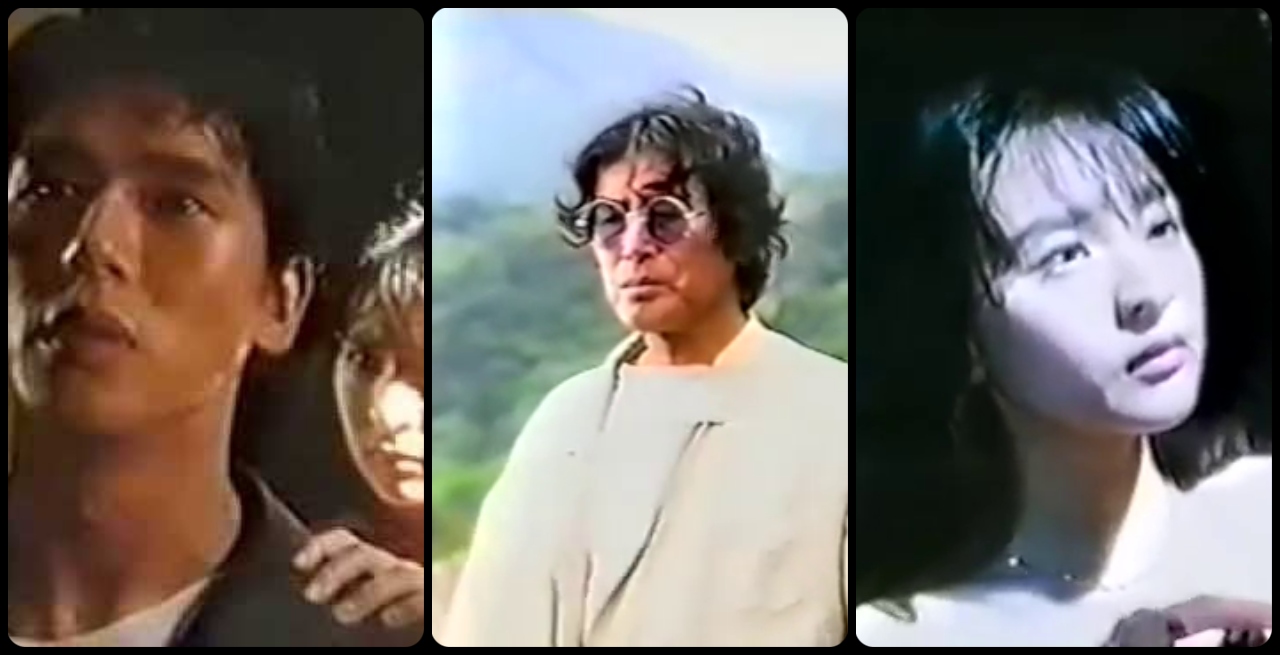
The popularity of Ring increased exponentially in 1998 with the Hideo Nakata movie,but it was not the first movie version of Koji Suzuki’s 1991 novel. That honour belongs to the feature length drama from 1995, widely known as Ring Kanzenban.
Ring (‘Accident, or unnatural death? A young girl’s hatred that steals four lives’) premiered on Fuji TV at 9:02pm on Friday 11 th August 1995 in their ‘Friday Night Entertainment’ slot, ending at 10:52pm. The release was timed to coincide with the forthcoming Obon (Festival of the Dead), and the recent publication of the second novel in the series, Spiral/Rasen, published in hardback a month prior.
Three months later, it was released on home video on 24th November 1995 with a new subtitle: Kanzenban, meaning complete version. It was released by Amuse Video with three covers for the VHS release: ‘psycho horror’, ‘sexual version’, and a third which was released later, and one cover for the Laserdisc. The content is the same between all Kanzenban releases.
‘Complete edition’ suggests that there is new footage; Meikle states in The Ring
Companion that the video release has “more nudity and stronger sex scenes”, and Lopez (theringworld.com) says that “the video version is the more breast obsessed of the two (which is putting it lightly – the scene where Tsuji Youko and Nomi Takehiko are fooling around in the car gets so graphic that the censoring usually reserved for pornographic films kicks in)”. Additionally, Kalat (J-Horror) says that Kanzenban was popular enough to be granted a limited theatrical release in 1996.
Before now, it has been difficult to find out what the exact changes are between the two versions; while the VHS of Kanzenban has been converted to digital and is widely available on the internet, the broadcast version remained elusive. There is little documented information as to what else was added to the home video release to make it ‘complete’, other than what has already been determined regarding its additional sex scene. However, I was in contact with someone recently who said they had a VHS tape containing the broadcast version as it was seen on Fuji TV, complete with ad breaks, so I found myself in a position to find out the differences between the two.
What follows is a comparison between the Kanzenban version and the broadcast version, with all changes being timestamped to match the more widely available Kanzenban version, available here.
To be as thorough as possible, all sponsors are translated, and all ad breaks are
timestamped to show where they occurred in the story in the Kanzenban release. Where there are no timestamps, it means that the versions are identical. All translations, unless otherwise noted, are my own.
B = Broadcast version
V = Video release
B begins by showing the sponsors for the first hour of the movie: Nestle, Yamahisa (estate agents), POLA (cosmetics), Kobayashi (pharmaceuticals) Hoyu (hair products), Japan Telecom (now SoftBank Telecom) and Sanyo Electronics.

Note on sponsors: the sponsors are not sponsoring the movie itself and have no say in its content. They are all the companies that paid to have Commercial Messages (CM) in the ad breaks. There can still be ads from other companies occasionally, but the sponsors pay to have the vast majority of ad time.
Note on music changes: when one scene has different music from the other, it will be noted with (M) after the time stamp. B has more varied but generic music, while V has a music box-like theme throughout.
- 2:57 – 3:52 (M) = Just after Tomoko’s death, and the title card. A different sound
effect leads into the scene with Asakawa in the taxi on each version. On B, there is
no music in the taxi sequence, whereas V has music play during the dialogue
between Asakawa and the taxi driver. - 4:28 – 5:07 (M) = Asakawa opens Shuichi’s motorcycle helmet. The sound effect
when the helmet is opened is different between each version. - 5:51 – 7:50 (M) = Tomoko’s funeral.
- 8:49 – 10:12 = Yoshino, Asakawa’s colleague, reveals the details of the discovery of
two bodies in a car to Asakawa (Takehiko and Youko). B shows the aftermath of the
scene, with still images of the bodies being discovered in the car and removed. V
instead has the couple indulge in some gratuitous foreplay before the curse strikes.
Audio syncs between the two at 9:39 with ‘this case is mysterious’ and plays
identical. The version of this scene in V is the additional stronger sex scene
mentioned earlier. Video of the scene in the B version here. - 11:11 – 11:45 (M) = Asakawa is piecing together details of all four victims, and the
audience get a still image of each of their bodies. The first two victims have the same
stills on both versions, but Takehiko and Youko have different ones. No blood present on
the B version, whereas V has a blood trickle from Takehiko’s mouth.
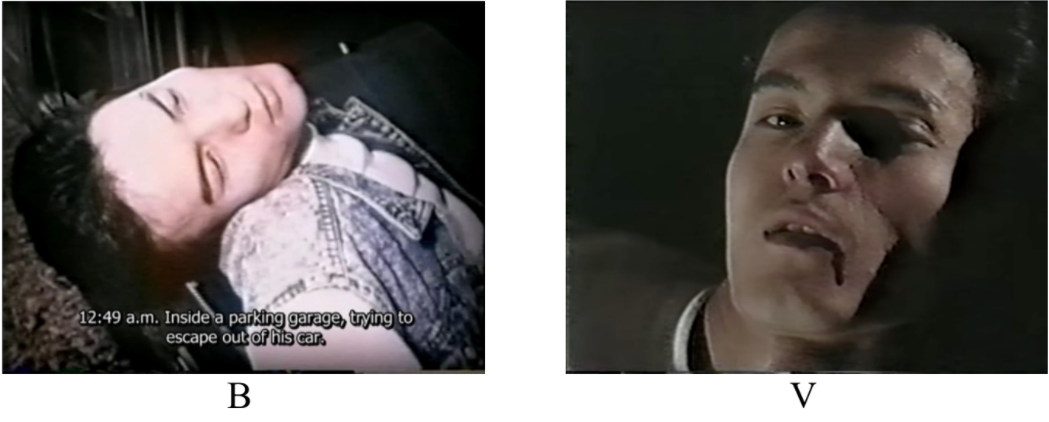
- 11:46 – 11:54 (M) = B has a still image of Youko clothed and V has her with exposed
breasts.
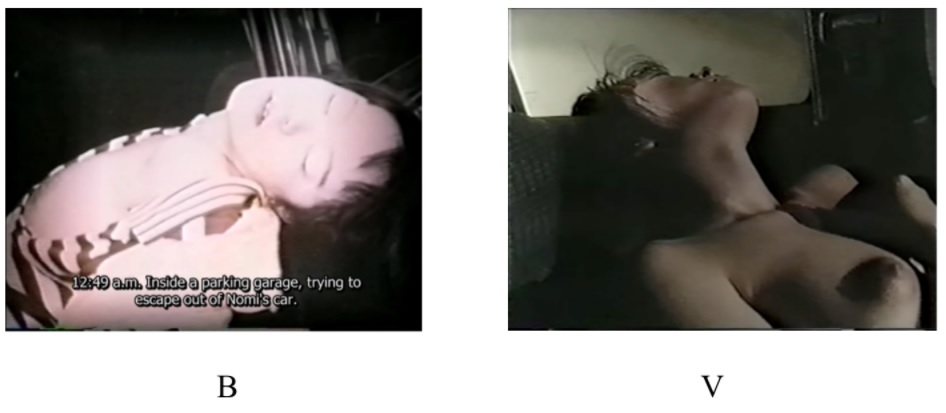
- 12:00 – 12:16 (M) = Asakawa discusses the four deaths with Yoshino.
- 18:15 – 19:05 (M) = The drive to South Hakone Pacific Land.
- 19:05 – 19:29 (M) = The walk to cabin B4. There is a gong sound effect when
Asakawa looks at the cabin number on the wall on B. On V, there is no sound effect. - 20:10 – 21:24 (M) = Asakawa reflecting on the murders while in and around cabin
B4. - 29:18 – 29:21 = The audience are shown images of the four victims again in quick
succession after Asakawa watches the video. The images of the original four victims
are the same as their respective versions, so B has the unbloodied Takehiko image, and
V has the topless image of Youko. They are exactly the same images as above. - 29:49 = Ad break.
- 29:49 – 30:20 (M) = Asakawa running down the street on his way to meet Ryuji. V
has a second or two of extra footage of Asakawa further away from the camera, and B starts after the ad break with him already halfway down the street (it should be
noted that this could be dependent on where in Japan my copy originated from;
there’s a possibility that the ads overran slightly in that region). The two versions
sync again at 30:20. - 34:10 – 35:21 (M) = Ryuji calls Asakawa after watching the tape. Asakawa drives to
Ryuji’s house. - 38:43 = Ad break.
- 40:23 – 42:41 (M) = Montage of Asakawa with his wife. At 41:12 on V, there is no
music while Ryuji is on the balcony, just crowd noise, leading until Sadako’s point at
41:24, whereas on B the music plays continuously and pauses only briefly just
before Sadako’s point, then resumes the music. The sound effects are different
during the point; B has a gong effect that is missing on V. - 48:33 – Ad break
- 51:14 – 52:15 (M) = Asakawa and Ryuji on Mount Mihara on Izu Oshima Island. On
B, the scene changes while Asakawa and Ryuji are standing on the hill together. On
V, instead of the scene change, Ryuji walks away from Asakawa. It then cuts to a
shot of Sadako standing at the bottom of the hill watching Asakawa unseen. - 54:43 = A reminder of sponsors for ads for the first hour, which was the same
screens shown earlier. A message then says “Friday Night Entertainment ‘Ring’.
Please continue to enjoy yourself”. Then follows an ad break. After these ads are new sponsors for most of the ads after this point. “From here on this broadcast will be sponsored by…” Kao (chemicals and cosmetics), Sunwave (now LIXIL, kitchen equipment), Canon, Nikka Whisky, Hagoromo Foods, Asahimatsu Foods, and Secom (security).

- 58:04 – 58:07 (M) = Each version has a different three second establishing shot. V shows a sunset then cuts to Asakawa running down the street, while B shows a
panning shot of buildings then cuts to Asakawa. Video from here on is the same.
Sync between the two again at 59:20.
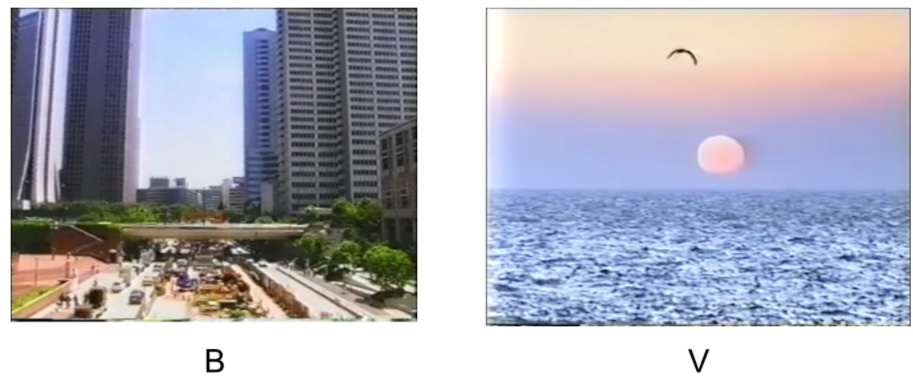
- 1.00:27 – 1.00:52 = A flashback of Sadako and her father in bed. V has a 10 second
longer frolicking in bed scene. B includes a brief glance at the onlookers’ eyes
instead, recycling an earlier shot. Syncs again at ‘otousan’ at 1.00:52. The B scene
can be found here. - 1.02:16 = Ad break.
- 1.11:36 = Ad break.
- 1.16:01 – 1.19:49 (M) = Asakawa and Ryuji in the well. Music differs only slightly
between the two versions. - 1.20:17 – 1.20:20 = On B, when Sadako pops up in the well, there is a dramatic
sound effect. This is missing on V, and there is no sound effect or music. - 1.22:54 – 1.23:47 = Ryuji dancing with Mai after the well sequence. V has different
music during the dance sequence and phone call, possibly a licensing issue. The
music in B has lyrics and in V it does not. - 1.23:47 – 1.25:11 (M) = Sadako appears to Ryujji.
- 1.31:43 – 1.31:56 (M) = Asakawa walks through the crowd, contemplating what to do
about the curse. On both versions, he turns around, sees nothing, and carries on
walking. On B, it plays his final line about Sadako’s revenge, then ends on a freeze
frame. On V, just after Asakawa turns around after seeing nothing, it cuts to Sadako
in the crowd while it plays his final line. This extension leads to an awkward few
seconds of silence as Asakawa walks until the freeze frame. - 1.31:59 – 1.33:39 = Credits are different between the two versions. B is shorter, and
shows the cursed video in full during credits, while V repeats parts of it to
accommodate the longer credits for the video release. - 1.33:43 – 1.36:30 = V plays the entire cursed video again after the credits. B ends
with a standard disclaimer: This drama is fiction. All characters, names, and
organisations that appear are fictitious.
In conclusion, there are four significant changes between the broadcast version and the video release. Two of them are the brief Sadako scenes that have been inserted into the video version that were not originally present in the broadcast version. The third is the sex scene early on with Takehiko and Youko, which is changed entirely. The forth is the slightly extended scene with Sadako in bed with her father. Music has been altered in places to add some more tension, and there are a few instances of sound effects being altered. There are no extra lines of dialogue.
Bibliography:
Kalat, David (2007) "J-Horror – The Definitive Guide to The Ring, The Grudge and
Beyond", Vertical Inc.
Lopez, Javier (2006)
https://web.archive.org/web/20050830115649/http://www.theringworld.com/kanzenb
an.php
Meikle, Denis (2005) "The Ring Companion", Titan Books
Mes, T. P. (2018) V-Cinema: Canons of Japanese Film and the Challenge of Video –
Leiden University
More Film Reviews:
The Awakening of Lilith (2021) Film Review – The Excruciating Weight of Loss
Sparked by the death of her partner Noah, Lilith is struggling with her mental health and has succumbed to a deep depression that affects all aspects of her life. Fighting…
Angels Fallen: Warriors of Peace (2024) Film Review – Zamani’s Next Installment in the Angels Fallen Universe
“Haunted by the war in Iraq, a depressed and faithless Gabriel is approached by the mysterious Balthazar, who recruits Gabriel to stop the evil Archangel Michael from raising an army…
Waxwork (1988) Film Review – As it Waxes Nostalgic
Waxwork (1988), Anthony Hickox’s directorial debut, is a half-baked comedy horror film with a tedious build-up, unmemorable characters, confusing lore, and a long-overdue payoff. Although it already fell at the…
Luzifer (2021) Film Review – Religious Fervor and Unforgiving Isolation
“Every day we stray further from God’s light” may be a ‘meme-able’ saying, but it is one that is none-the-less true when we look at a mix of contempt and…
Puzzle Box (2023) Film Review – A Found-Footage/Liminal Nightmare
I am a fan of found footage films, but let’s be honest, they’re mostly hit or miss. Only a few actually stand out among the sea of “Blair Witch” copycats…
Broadcast Signal Intrusion (2021) Film Review: Descending Into an All-Consuming Obsession
There are very few horror movies that linger in the brain well after viewing, like fine wine on the tongue, dragging your thoughts back over and over to replay it…
